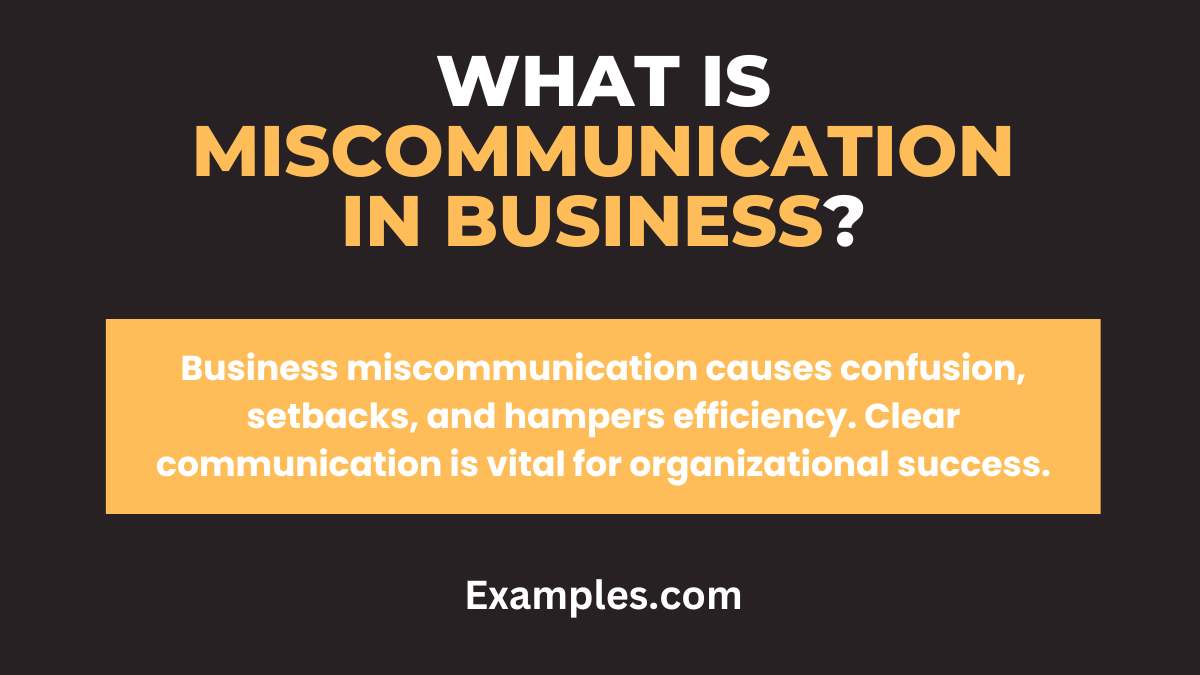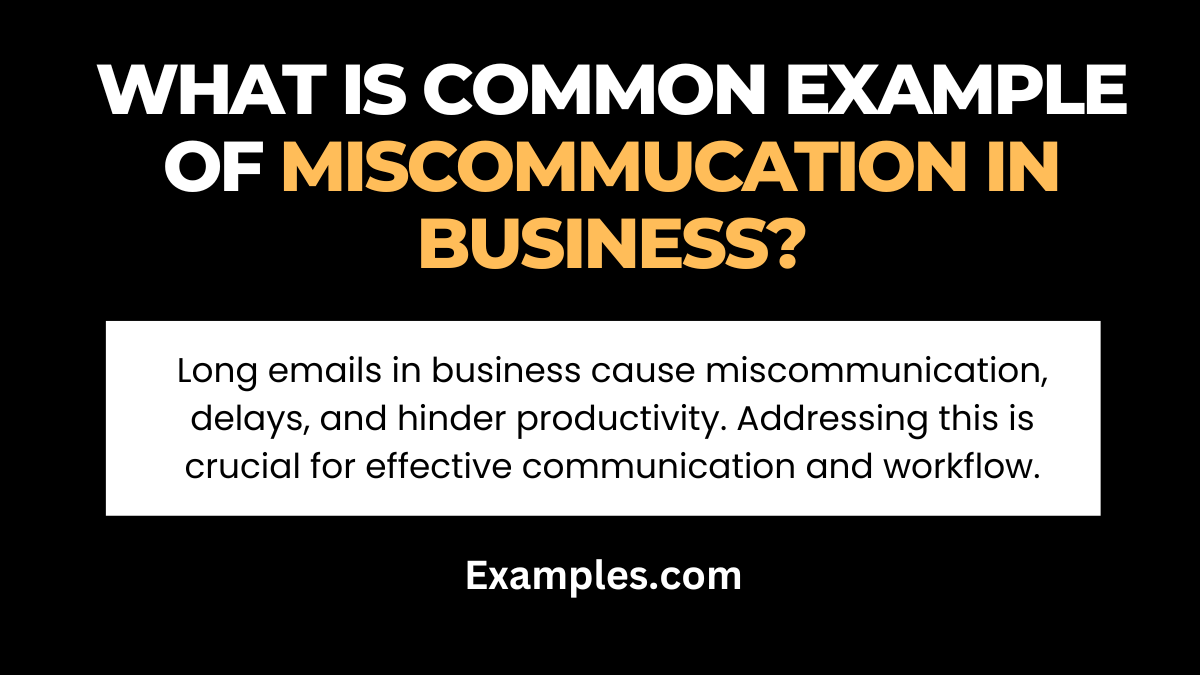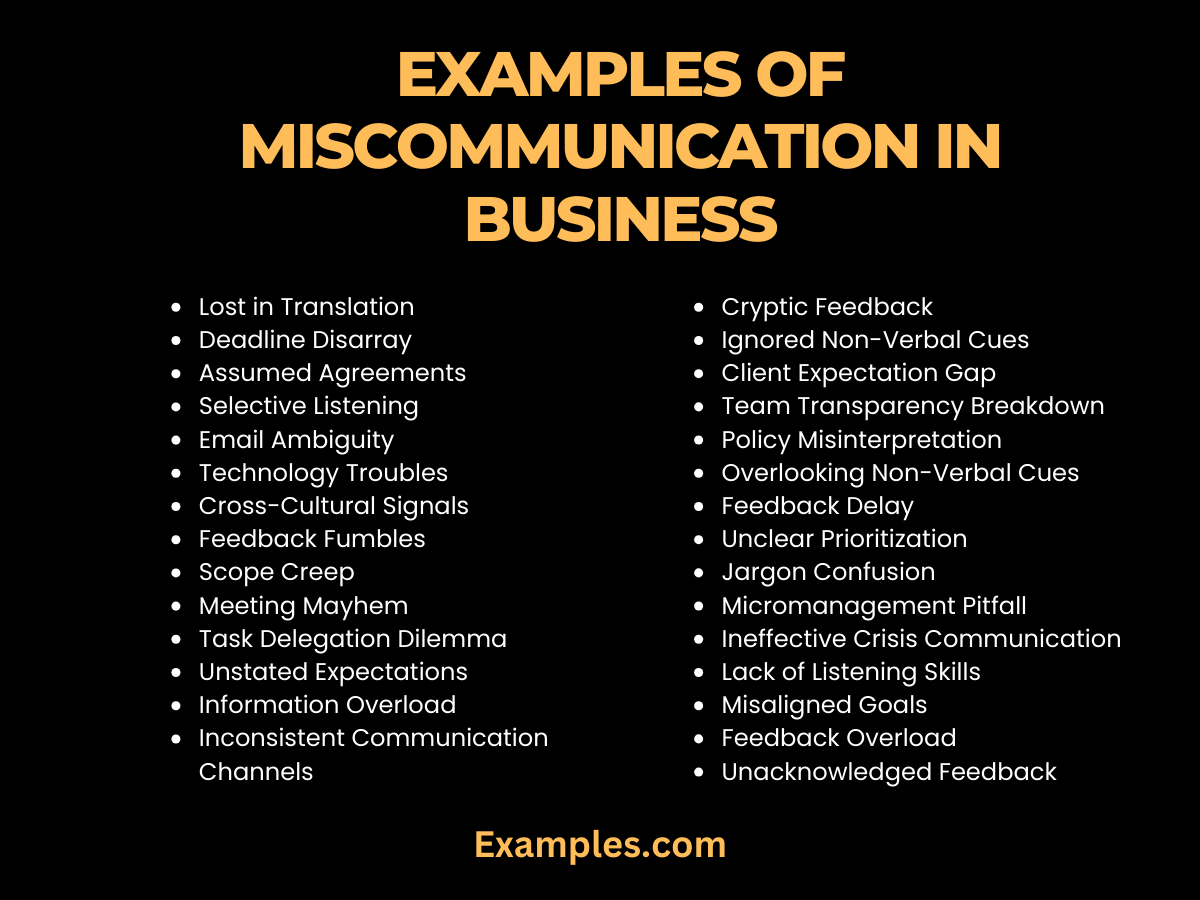29+ Miscommunication in Business Examples
Unlock the secrets of effective communication with our comprehensive guide on miscommunication in business. Dive deep into real-world scenarios and enrich your unders the corporate realm. Elevate your communication skills, troubleshoot common pitfalls, and enhance collaboration with this indispensable resource. Master the art of effective business communication today!
What is Miscommunication in Business?-Definition

Miscommunication in business refers to instances where information is not effectively conveyed or understood as intended. It occurs when messages are distorted, leading to confusion, errors, and potential setbacks. In simpler terms, it’s the breakdown of communication that hinders the smooth exchange of ideas, impacting organizational efficiency. Understanding this concept is crucial for fostering clear communication and preventing misunderstandings in the dynamic landscape of business interactions.
What is the most common Example of Miscommunication in Business?

In the fast-paced world of business, a prevalent example of miscommunication unfolds in lengthy email chains. As messages pass between team members, key details may get lost, leading to misunderstandings. A classic scenario involves overlooking crucial attachments or misinterpreting the sender’s tone. This misalignment can result in delayed projects, frustrated teams, and hindered productivity. Understanding and addressing these pitfalls is vital for cultivating effective communication within a business environment.
30 Examples of Miscommunication in Business

Embark on a journey through 30 illuminating miscommunications in business, exposing the intricacies that can hinder success. Explore real-world examples and gain valuable insights into avoiding and fixing these common pitfalls. Elevate your communication strategy, foster collaboration, and ensure seamless business interactions with this indispensable guide.
- Lost in Translation:
How to Avoid: Clearly define terminology.
How to Fix: Schedule a clarification session. - Deadline Disarray:
How to Avoid: Set clear deadlines.
How to Fix: Establish a revised timeline and prioritize tasks. - Assumed Agreements:
How to Avoid: Confirm agreements explicitly.
How to Fix: Hold a meeting to clarify expectations. - Selective Listening:
How to Avoid: Encourage active listening.
How to Fix: Recap key points and seek confirmation. - Email Ambiguity:
How to Avoid: Craft clear, concise emails.
How to Fix: Request clarification and confirm details. - Technology Troubles:
How to Avoid: Use centralized communication tools.
How to Fix: Conduct regular message reviews. - Cross-Cultural Signals:
How to Avoid: Foster cultural awareness.
How to Fix: Address cultural differences openly. - Feedback Fumbles:
How to Avoid: Be specific in feedback.
How to Fix: Provide detailed guidance for improvement. - Scope Creep:
How to Avoid: Clearly define project scope.
|How to Fix: Renegotiate project boundaries. - Meeting Mayhem:
How to Avoid: Create agendas for meetings.
How to Fix: Recap meeting outcomes and assign action items. - Task Delegation Dilemma:
How to Avoid: Clearly assign tasks.
How to Fix: Reevaluate responsibilities and communicate changes. - Unstated Expectations:
How to Avoid: Establish clear expectations.
How to Fix: Communicate expectations transparently. - Information Overload:
How to Avoid: Prioritize critical information.
How to Fix: Summarize key points for clarity. - Inconsistent Communication Channels:
How to Avoid: Standardize communication tools.
How to Fix: Streamline communication platforms. - Undefined Roles:
How to Avoid: Clearly define team roles.
How to Fix: Reevaluate and assign roles accordingly. - Cryptic Feedback:
How to Avoid: Offer context in feedback.
How to Fix: Hold a feedback discussion for clarity. - Ignored Non-Verbal Cues:
How to Avoid: Train teams on non-verbal cues.
How to Fix: Encourage open discussion about non-verbal signals. - Client Expectation Gap:
How to Avoid: Align expectations upfront.
How to Fix: Clearly communicate project limitations. - Team Transparency Breakdown:
How to Avoid: Encourage open communication.
How to Fix: Address and share withheld information. - Policy Misinterpretation:
How to Avoid: Provide clear policy documentation.
How to Fix: Conduct training on company policies. - Overlooking Non-Verbal Cues:
How to Avoid: Emphasize virtual communication etiquette.
How to Fix: Discuss non-verbal cues in team meetings. - Feedback Delay:
How to Avoid: Establish timely feedback cycles.
How to Fix: Prioritize prompt feedback on projects. - Unclear Prioritization:
How to Avoid: Establish task priorities.
How to Fix: Reevaluate priorities and communicate changes. - Jargon Confusion:
How to Avoid: Explain industry terms.
How to Fix: Provide a glossary of industry-specific terminology. - Micromanagement Pitfall:
How to Avoid: Set clear expectations for autonomy.
How to Fix: Establish trust and delegate responsibly. - Ineffective Crisis Communication:
How to Avoid: Create a crisis communication plan.
How to Fix: Clearly communicate action steps during a crisis. - Lack of Listening Skills:
How to Avoid: Conduct listening skills workshops.
How to Fix: Encourage active participation in discussions. - Misaligned Goals:
How to Avoid: Clearly define project goals.
How to Fix: Realign team goals and communicate adjustments. - Feedback Overload:
How to Avoid: Prioritize feedback points.
How to Fix: Provide focused feedback on critical areas. - Unacknowledged Feedback:
How to Avoid: Promote a culture of feedback.
How to Fix: Initiate discussions to address and implement feedback.
What causes bad communication in business?
- Ambiguous Messaging: Ensure messages are concise and specific to avoid misinterpretation.
- Assumption and Presumption: Encourage seeking clarification to avoid premature conclusions.
- Roles and Responsibilities Clarity: Clearly define and communicate individual responsibilities to avoid confusion.
- Poor Listening Skills: Hone active listening skills to comprehend information fully.
- Technological Hurdles: Choose appropriate communication tools and provide necessary training.
- Cultural Differences: Foster cultural awareness and encourage open dialogue to bridge communication gaps.
- Lack of Feedback Mechanism: Establish a feedback culture to facilitate continuous improvement.
- Information Overload: Prioritize and streamline communication to ensure key points are emphasized.
- Unclear Expectations: Clearly articulate expectations to set a common understanding.
- Ineffective Leadership Communication: Prioritize transparent communication to guide teams successfully.



